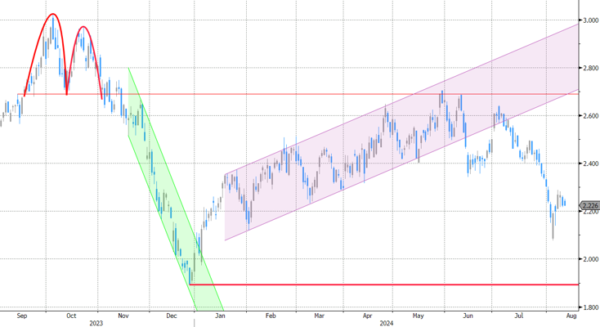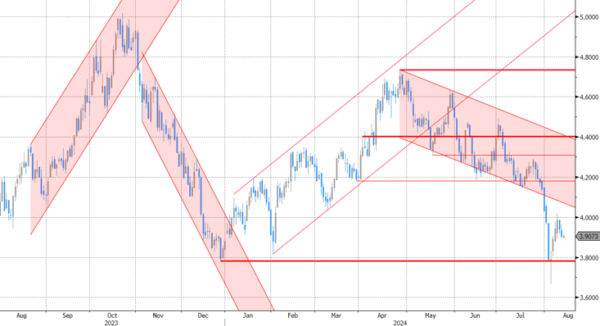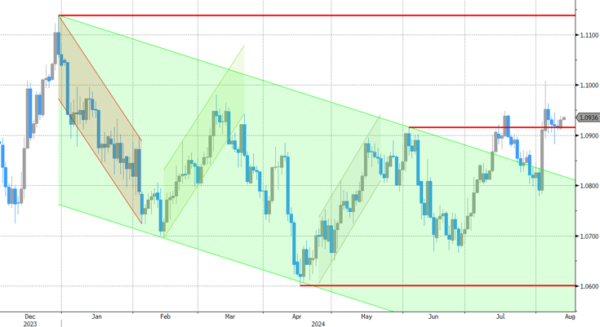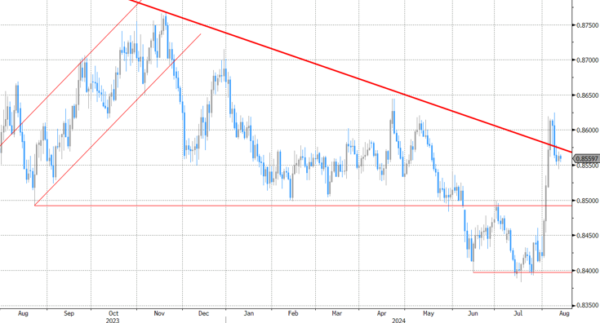Markets
Japanese stock markets outperform this morning (Nikkei +3%) after returning from a long weekend (closed for Mountain Day yesterday). The index now recovered from Monday’s meltdown, but is still 7% below the levels of the July 31 Bank of Japan meeting with set things on fire. The BoJ’s 15 bps rate hike triggered a JPY (and volatility) carry trade unwind with disappointing US manufacturing ISM and payrolls fueling the move. Calm only returned after BoJ deputy governor Uchida assured investors that the central bank won’t be raising rates further as long as market instability persists. That way, he did also put the BoJ in the most undesirable position of handing its autonomy to financial markets. The US recession risk narrative lost steam following a good non-manufacturing ISM. During the second half of last week, market recovered somewhat from the sharp moves early August with the next test arriving this week especially in the form of US inflation numbers.
US July producer price inflation today serves as an amuse-bouche ahead of consumer prices tomorrow. Consensus expects 0.2% M/M increases for both headline and core readings. Benign inflation prints will be cheered for by stock markets as they enable the Fed to zoom in on the maximum employment part of their dual mandate without having to worry about (additional) price pressure. US money markets are currently split between a 25 bps and a 50 bps lift-off rate cut at the September 18 policy meeting. Official Fed talk doesn’t mention the latter possibility. Fed Bowman over the weekend for example said she still sees upward inflation risks and may not be ready to support an interest rate decrease in September at all. We only think that a 50 bps could come into play in case of disappointing activity/labour market data early September. The downside of the front end of the curve might therefore be protected in the wake of the violent early August repositioning. US Treasuries still outperformed yesterday but that had more to do with haven-flows related to tensions in the Middle East (see News & Views). Daily curve changes varied between -1.8 bps (30-yr) and -5 bps (5-yr). German yields ended the day close to unchanged. The dollar marginally lost out against the euro, closing the day at EUR/USD 1.0939 from a start at 1.0914. USD/JPY set a minor August recovery high at 148.22 (from 146.73). Apart from US PPI data, German ZEW investor sentiment and US NFIB small business optimism are scheduled for release, but these are second tier. Comments by Atlanta Fed Bostic serve as a wildcard.
UK labour market data this morning started the UK monthly update. Employment rose by 97k in the April-June quarter, beating 3k consensus. The first indication for Q3 (July payrolls) was better-than-hoped as well (+24k vs +10k expected). A significant increase in jobless claims (+135k in July) is the odd one out. Weekly earnings ex bonuses rose as expected by 5.4% annualized in Q2. Sterling in a first move profits with EUR/GBP testing the recent lows around 0.8550. UK inflation numbers (tomorrow), Q2 GDP data (Thursday) and retail sales (Friday) follow later this week.
News & Views
The Organization of Petroleum Exporting Countries (OPEC) yesterday trimmed its forecasts for world oil demand growth this year by 135k barrels/day. The slight revision reflects actual data for Q1 and Q2 as well as lower expectations for China’s oil demand growth. OPEC sees oil consumption increasing by 2.1mn b/d this year to average 104.3mn b/d. That’s still way more optimistic than other forecasters and above pre-pandemic growth levels. The downward revision in its monthly report comes at a sensitive time as the cartel plans to unwind oil production cuts (2.2mn b/d) from Q4 onwards, starting with roughly 543 b/d of additional supply. Oil prices didn’t respond to the OPEC bulletin. They even rallied back from $80/b to $82/b as tensions in the Middle East increase. US officials indicated that they believe an Iranian attack against Israel (in a retaliation after the assassination of Hamas leader Haniyeh in Tehran) is ever more likely and could come as soon a this week. The US also shored up naval and air forces in the region to help Israel fend off any such possible major attack.
Graphs
GE 10y yield
The ECB cut policy rates by 25 bps in June. Stubborn inflation (core, services) make follow-up moves less evident. Markets nevertheless price in two to three more cuts for 2024 as disappointing US and unconvincing EMU activity data rolled in, dragging the long end of the curve down. The move accelerated during the early August market meltdown.
US 10y yield
The Fed in its July meeting paved the way for a first cut in September. It turned attentive to risks to the both sides of its dual mandate as the economy is continuing to move better in to balance. The pivot weakened the technical picture in US yields with another batch of weak eco data pushing the 10-yr sub 4%. This week’s inflation numbers are the next benchmark.
EUR/USD
EUR/USD moved above the 1.09 resistance area as the dollar lost interest rate support at stealth pace. US recession risks and bets on fast and large (50 bps) rate cuts trumped traditional safe haven flows into USD. EUR/USD 1.10 (psychologic) and 1.1139 (Dec 2023 high) serve as next technical references.
EUR/GBP
The BoE delivered a hawkish cut in August. Policy restrictiveness will be further unwound gradually and on a pace determined by a broad range of data. The strategy similar to the ECB’s balances out EUR/GBP in a monetary perspective. Risk-off proved a more important driver of GBP recently, triggering a return from 0.84 towards 0.86.
















